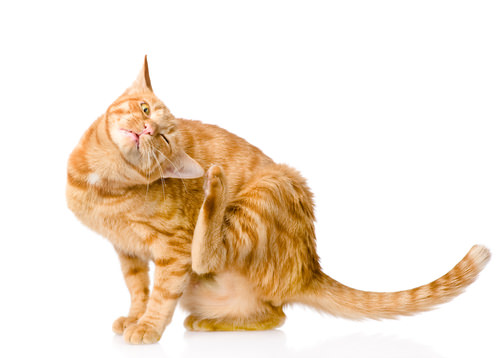
One of the most common reasons for a cat to lose hair is a flea allergy. The hair loss often results from excessive grooming. Fleas themselves cause itching and irritation, but flea saliva is one of the most irritating substances on the planet. If your cat becomes allergic to flea saliva, it will only take a single flea bite to kick off a cascade of itching and irritation for the cat and it makes cats miserable.
Understand that it is not a flea infestation that causes the problem because only a single bite is required to start the cycle. ONE FLEA BITE is all that it takes. You will not see fleas on your cat. It will have bitten her and jumped off to lay its eggs in the environment. It does not matter if your cat stays indoors all the time and you have never seen a flea. It doesn’t matter if it is the middle of winter because your house is warm.
Affected cats will have hair loss starting at the base of the tail. Many times it will be accompanied by scabbing. The scabbing is known as miliary dermatitis and can be anywhere on the body, specifically around the neck and over the base of the tail. The cats are super itchy.
Hair loss will necessitate a visit to the vet, but there are things that you can do at home to get rid of fleas even if you aren’t seeing them, even before you go.
- Treat every animal in the environment, even if he is only indoors for a little while. If your outdoor dog comes in sometimes to visit, he needs to be on an effective product. There are countless products out there and some are not effective at all. Ask your veterinary staff which is the most likely to work.
- Treat entire premises with an insecticide that also prevents eggs from hatching. Even if you have hardwood floors, treat the environment with an insect growth regulator to stop hatches. New fleas will hatch out all the time and remember, it only takes one bite on your cat to start the process all over.
- Make sure to cover unusual sources of fleas, like your car and your entry ways. If you have wildlife in your yard, they can serve as an unaccounted for source of fleas. If your pet ever rides in your car or you could carry a flea in on your pants leg, the car should be treated to. Sprinkle insecticide with growth regulator near doorways, so fleas can’t hitch a ride inside as you pass.
Make sure you have accounted for fleas as a source of hair loss for your cat. Follow these guidelines and talk with your vet. There can be other causes of hair loss for cats, so if you do these steps and the problem does not resolve, write down exactly what you have tried to take with you to the vet visit. Most cases of hair loss can be treated and improved, so it is worth the effort.
